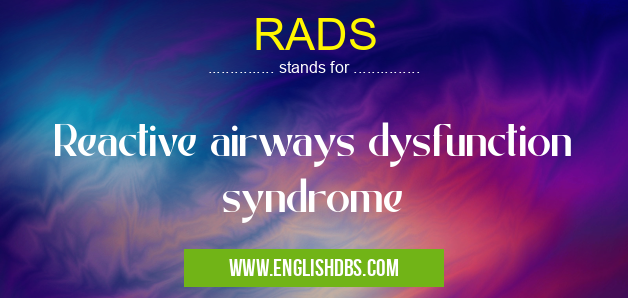What does RADS mean in HEALTHCARE
RADS (Reactive Airways Dysfunction Syndrome) refers to a chronic respiratory condition characterized by persistent airway inflammation and hyperresponsiveness following a single or multiple exposures to certain triggers. It is often seen in individuals who have experienced chemical or irritant exposure in the workplace or environmental settings.

RADS meaning in Healthcare in Medical
RADS mostly used in an acronym Healthcare in Category Medical that means Reactive airways dysfunction syndrome
Shorthand: RADS,
Full Form: Reactive airways dysfunction syndrome
For more information of "Reactive airways dysfunction syndrome", see the section below.
» Medical » Healthcare
Causes
RADS can be caused by exposure to various triggers, including but not limited to:
- Chemical fumes: Isocyanates, diisocyanates, aldehydes
- Irritants: Chlorine, ammonia, ozone, smoke, dust
- Biological agents: Endotoxins, grain dust, animal dander
Symptoms
Individuals with RADS may experience a range of symptoms, such as:
- Cough: Dry, persistent
- Wheezing: Audible whistling sound during breathing
- Shortness of breath: Difficulty in catching breath
- Chest tightness: Feeling of pressure or tightness in the chest
- Fatigue: Persistent tiredness
- Headaches: Frequent or persistent
Diagnosis
Diagnosing RADS involves:
- Medical history: Assessment of exposure to potential triggers and symptoms
- Spirometry: Measuring lung function to assess airflow limitations
- Bronchial challenge testing: Exposing the airways to specific triggers to observe airway response
- Chest radiography: Excluding other lung conditions
Treatment
Treatment for RADS focuses on:
- Avoiding triggers: Identifying and minimizing exposure to known triggers
- Medications: Inhalers (beta-agonists, corticosteroids) to control airway inflammation and bronchospasm
- Oxygen therapy: Supplemental oxygen to improve breathing
- Pulmonary rehabilitation: Exercise and education programs to improve respiratory function
Essential Questions and Answers on Reactive airways dysfunction syndrome in "MEDICAL»HEALTHCARE"
What is Reactive Airways Dysfunction Syndrome (RADS)?
Reactive airways dysfunction syndrome (RADS) is a condition characterized by persistent irritation and inflammation of the airways, often triggered by exposure to certain irritants or chemicals. It is a type of reactive airway disease, which is a group of conditions that cause airways to become sensitive and overreact to triggers.
What causes RADS?
The exact cause of RADS is unknown, but it is believed to be caused by exposure to irritant gases or chemicals, such as those found in smoke, fumes, or industrial workplaces. Certain respiratory infections and medications can also trigger RADS.
What are the symptoms of RADS?
Symptoms of RADS include coughing, wheezing, shortness of breath, chest tightness, and airway irritation. Symptoms can be triggered by exposure to certain irritants or chemicals, or they can occur spontaneously.
How is RADS diagnosed?
RADS is diagnosed based on a patient's symptoms, medical history, and a physical examination. A doctor may also perform breathing tests, such as spirometry, to assess lung function.
How is RADS treated?
Treatment for RADS focuses on reducing exposure to triggers, managing symptoms, and preventing complications. Treatment may include bronchodilators, inhaled corticosteroids, and other medications to open up the airways. Avoiding triggers is essential for managing RADS.
Can RADS be cured?
RADS is a chronic condition, but it can be managed with proper treatment and avoidance of triggers. With treatment, most people with RADS can live normal, active lives.
Is RADS related to asthma?
RADS and asthma are both reactive airway diseases, but they are different conditions. RADS is caused by exposure to specific irritants or chemicals, while asthma is often triggered by allergens or other factors.
Final Words: RADS is a chronic respiratory condition caused by exposure to specific triggers. Symptoms range from cough, wheezing, and shortness of breath to fatigue and headaches. Diagnosis involves a comprehensive evaluation, including medical history, lung function testing, and potential bronchial challenge testing. Treatment aims to avoid triggers, control airway inflammation, and improve respiratory function. Early recognition and management of RADS are crucial to prevent long-term respiratory complications.
RADS also stands for: |
|
| All stands for RADS |
